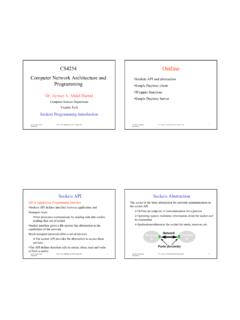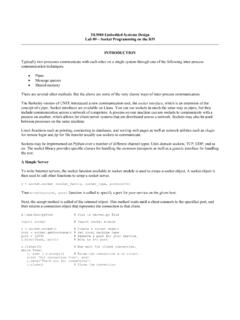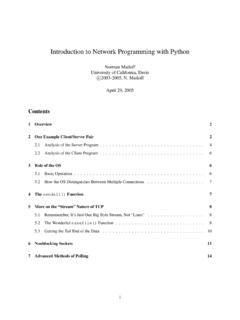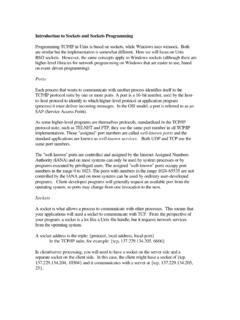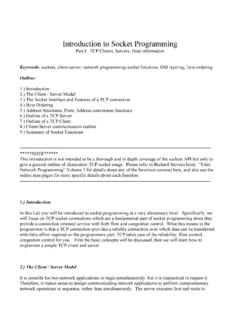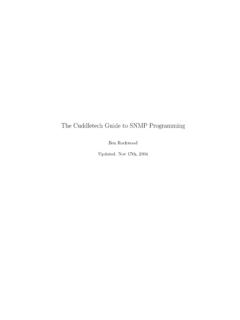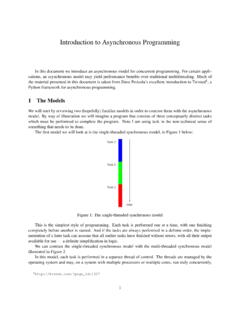Transcription of An Introduction to Socket Programming - preterhuman.net
1 An Introduction to Socket Programming (by) Reg Quinton $Id: ,v 1997/05/02 20:17:16 reggers Exp $ Contents: Introduction BEWARE Existing Services Netstat Observations Host names and IP numbers Programming Calls Services and Ports Programming Calls Socket Addressing File Descriptors and sockets File Descriptors sockets Client Connect Client Communication Stdio Buffers Server Applications Server Bind Listen and Accept Inetd Services Inetd Comments Whois Daemon Running the Daemon The Code Connecting to the Server Whois Client Perl Socket Programming Final Comments Note Well Suggested Reading Author Introduction :These course notes are directed at Unix application programmers who want to develop client/serverapplications in the TCP/IP domain (with some hints for those who want to write UDP/IPapplications). Since the Berkeley Socket interface has become something of a standard these notes willapply to programmers on other platforms.
2 Fundamental concepts are covered including network addressing, well known services, sockets andports. Sample applications are examined with a view to developing similar applications that serveother contexts. Our goals are to develop a function, tcpopen(server,service), to connect to service. 1 of 01:22An Introduction to Socket Programmingfile:///C|/Eigene Dateien/Manualz/not to Socket develop a server that we can connect to. This course requires an understanding of the C Programming language and an appreciation of theprogramming environment (ie. compilers, loaders, libraries, Makefiles and the RCS revision controlsystem). If you want to know about Socket Programming with perl(1) then see below but you shouldread everything first. Our example is the UWO/ITS whois(1) service -- client and server sources available in: Network Services: Look for the whois(1) client and the whoisd(8) server.
3 You'll find extensive documentation on theUWO/ITS Whois/CSO server -- that's the whoisd(8) server. It also includes some Perl clients whichaccess the server to provide a gateway service (for the Finding People Web page and for CSO/PHclients). The Unix whois(1) client will be pretty obvious after you've read these notes. BEWARE:If C code scares you, then you'll get some concepts but you might be in the wrong need to be a programmer to write programs (of course). This isn't an Introduction to C(or Perl)! Existing Services:Before starting, let's look at existing services. On a Unix machine there are usually lots of TCP/IP andUDP/IP services installed and running: [1:17pm julian] netstat -aActive Internet connections (including servers)Proto R-Q S-Q Local Address Foreign Address (state)tcp 0 0 ESTABLISHEDtcp 0 0 TIME_WAITtcp 0 13 ESTABLISHEDtcp 0 0 ESTABLISHEDtcp 0 0 ESTABLISHEDtcp 0 0 ESTABLISHEDtcp 0 0 ESTABLISHED 0 0 *.
4 Printer *.* LISTENtcp 0 0 *.smtp *.* LISTENtcp 0 0 *.waisj *.* LISTENtcp 0 0 *.account *.* LISTENtcp 0 0 *.whois *.* LISTENtcp 0 0 *.nntp *.* LISTEN 0 0 *.ntp *.*udp 0 0 *.syslog *.*udp 0 0 *.xdmcp *.*Netstat Observations:Inter Process Communication (or IPC) is between pairs (or if you like). Aprocess pair uses the connection -- there are client and server applications on each end of the IPCconnection. Note the two protocols on IP -- TCP (Transmission Control Protocol) and UDP (User Datagram2 of 01:22An Introduction to Socket Programmingfile:///C|/Eigene Dateien/Manualz/not to Socket ). There's a third protocl ICMP (Internet Control Message Protocol) which we'll not lookat -- it's what makes IP work in the first place!
5 We'll be looking in more detail at TCP services and will not look at UDP -- but see a sample AccessControl List client/server pair which uses UDP services, you'll find that in: Access Control Lists: TCP services are connection orientated (like a stream, a pipe or a tty like connection) while UDPservices are connectionless (more like telegrams or letters). We recognize many of the services -- SMTP (Simple Mail Transfer Protocol as used for E-mail),NNTP (Network News Transfer Protocol service as used by Usenet News), NTP (Network TimeProtocol as used by xntpd(8)), and SYSLOG is the BSD service implemented by syslogd(1M). The netstat(1M) display shows many TCP services as ESTABLISHED (there is a connection and ) and others in a LISTEN state (a server application is listening at a portfor client connections). You'll often see connections in a CLOSE_WAITE state -- they're waiting forthe Socket to be torn down.
6 Host names and IP numbers:Hosts have names (eg. ) but IP addressing is by number (eg. [ ]). In the olddays name/number translations were tabled in /etc/hosts. [2:38pm julian] page /etc/hosts# /etc/hosts: constructed out of private data and DNS. Some machines# need to know some things at boot time. Otherwise, rely on DNS.# days name to number translations are implemented by the Domain Name Service (or DNS) --see named(8). and (4). [2:43pm julian] page / # $Author: reggers $# $Date: 1997/05/02 20:17:16 $# $Id: ,v 1997/05/02 20:17:16 reggers Exp $# $Source: /usr/ ,v $# $Locker: $## The default / for the ITS solaris systems.#nameserver Programming Calls:Programmers don't scan /etc/hosts nor do they communicate with the DNS. The C library routines3 of 01:22An Introduction to Socket Programmingfile:///C|/Eigene Dateien/Manualz/not to Socket (3) (and gethostbyaddr(3) on the same page) each return a pointer to an object withthe following structure: struct hostent { char *h_name; /* official name */ char **h_aliases; /* alias list */ int h_addrtype; /* address type */ int h_length; /* address length */ char **h_addr_list; /* address list */};#define h_addr h_addr_list[0] /* backward compatibility */The structure h_addr_list is a list of IP numbers (recall that a machine might have severalinterfaces, each will have a number).
7 Good programmers would try to connect to each address listed in turn (eg. some versions of ftp(1) dothat). Lazy programmers (like me) just use h_addr -- the first address listed. But see the acl(1) andacld(8) example noted earlier -- the client will try each server until it gets an answer or runs out ofservers to ask. Client applications connect to a (cf. netstat output) for a service provided by the applicationfound at that address. Proto R-Q S-Q Local Address Foreign Address (state)tcp 0 0 ESTABLISHEDtcp 0 13 ESTABLISHEDThe connection is usually prefaced by translating a host name into an IP number (but if you knew theIP number you could carefully skip that step). int tcpopen(host,service)char *service, *host;{ struct hostent *hp; if ((hp=gethostbyname(host)) == NULL) then say "carefully" because the IP address is a structure of 4 octets.}
8 Watch out for byte ordering. Anunsigned long isn't the same octet sequence on all machines. See byteorder(3N) for host to netconversions (host format to/from network format). Services and Ports:Services have names (eg. SMTP the Simple Mail Transfer Protocol). Ports have numbers (eg. SMTPis a service on port 25). The mapping from service names to port numbers is listed in /etc/services. [1:22pm julian] page /etc/services# $Author: reggers $# $Date: 1997/05/02 20:17:16 $## Network services, Internet style 21/tcptelnet 23/tcpsmtp 25/tcp mail4 of 01:22An Introduction to Socket Programmingfile:///C|/Eigene Dateien/Manualz/not to Socket 43/tcp nicnamedomain 53/tcp nameserverdomain 53/udp nameservertftp 69/udpfinger 79/tcpnntp 119/tcp readnews untpntp 123/udpsnmp 161/udpxdmcp 177/udp xdm Calls:But programmers don't scan /etc/services, they use library routines.
9 The C library routinesgetservbyname(3N) (and getservbyport(3N) on the same page) each return a pointer to an object withthe following structure containing the broken-out fields of a line in /etc/services. struct servent { char *s_name; /* name of service */ char **s_aliases; /* alias list */ int s_port; /* port for service */ char *s_proto; /* protocol to use */};Client applications connect to a service port. Usually this is prefaced by translating a service name(eg. SMTP) into the port number (but if you knew the port number you could carefully skip thatstep). int tcpopen(host,service)char *service, *host;{ struct servent *sp; if ((sp=getservbyname(service,"tcp")) == NULL) then to determine the port number for a particular tcp service. Note that you'd do the same todetermine port numbers for UDP services.}
10 Socket Addressing:A Socket Address is a pair (communication is between pairs -- one on the server,the other on the client). We know how to determine host numbers and service numbers so we're wellon our way to filling out a structure were we specify those numbers. The structure is sockaddr_in,which has the address family is AF_INET as in this fragment: int tcpopen(host,service)char *service, *host;{ int unit; struct sockaddr_in sin; struct servent *sp; struct hostent *hp; if ((sp=getservbyname(service,"tcp")) == NULL) then if ((hp=gethostbyname(host)) == NULL) then bzero((char *)&sin, sizeof(sin)); ; bcopy(hp->h_addr,(char *)& , hp->h_length);5 of 01:22An Introduction to Socket Programmingfile:///C|/Eigene Dateien/Manualz/not to Socket >s_port; code fragment is filling in the IP address type AF_INET, port number and IP address in the SocketAddress structure -- the address of the remote where we want to connect to find a service.}










